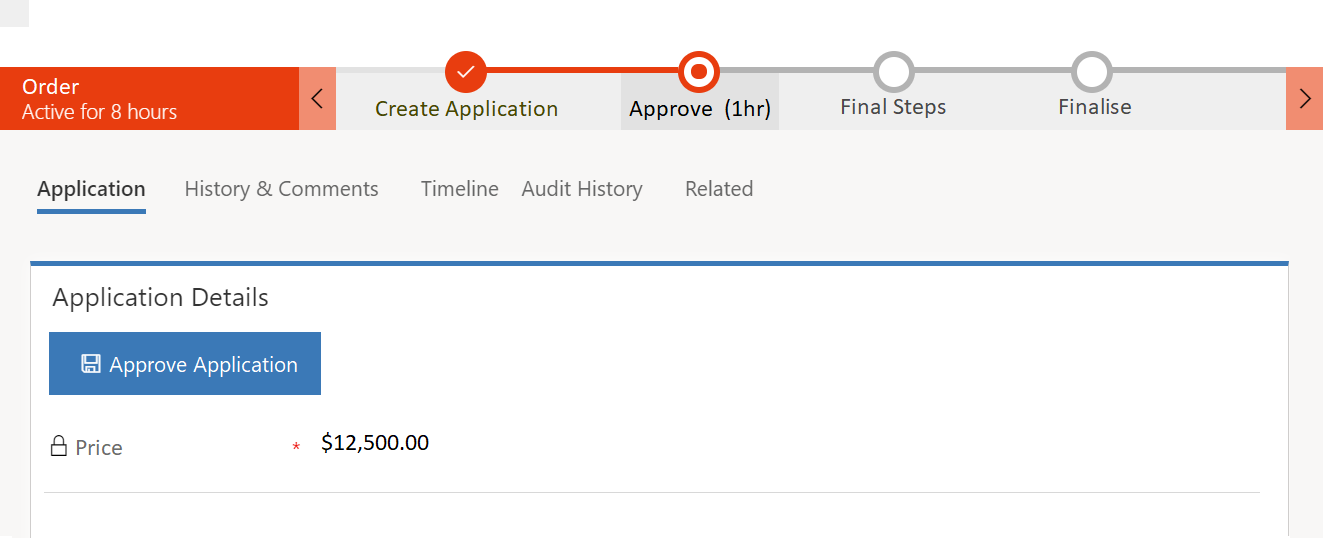Navigate Stages of a Business Process Flow
This post describes, at a high level, how to programmatically navigate stages of a business process flow (BPF). It also describes how to control what’s presented on the Dynamics 365 form at each of these stages. This will be achieved by describing how the following example was implemented.
Example
Consider the following Dynamics 365 form (Figures 1 & 2) which includes a simple approval BPF.


Pressing the ‘Submit Application’ button (Figure 2) results in:
- the BPF moving to the ‘Approve’ stage (assuming that ‘Price’ is populated)
- hiding the ‘Submit Application’ button
- displaying the ‘Approve Application’ button
- locking the price field.

Implementation
The Business Process Flow
Figure 4 represents the Approval BPF. The definition of the BPF is stored in the entity called cpl_approvalbpf (renamed from the generated name cpl_bdf_5f333d21bfc04c97a48d5b47085445ce). This entity stores information about the BPF such as: Traversed Path (which stages have been executed), Active stage & Duration.

Note: Regarding the Microsoft Tooling, the functionality of their BPF form designer seems a bit limited. For example, in the peer branch containing the condition ‘Not Rejected’, it was necessary to duplicate the ‘Final Steps’ stage. Also, there can only be one final stage or every branch needs there own final stage as shown in Figure 5.
(It’s necessary to use the ‘Connector’ option to join conditions and branches together.)

After the BPF is created, it needs to be added to a Dynamics 365 model driven app by using the App Designer.

Analysing the Business Process Flow
As described above, at each stage of the BPF, different components will be shown, hidden or locked on the Dynamics 365 form. To achieve this, the GUID of each BPF stages needs to be known. This can be determined by viewing the ‘Process Stage’ entities via FetchXML or the CRM REST Builder, as shown below

A section of the response is as follows:

Note: The processstageid from Figure 8 is referenced on line 75 of Figure 10
Using JavaScript to implement the logic
A file called workflow.html file is added to Dynamics 365 as a web resource and placed on the form (i.e. the ‘Application Details’ section of the form displayed in Figures 1 & 2)

The contents of workflow.html is displayed in Figure 10. It’s this file that implements the logic described in the overview section of this post. That is:
- the ‘Submit/Approve Application’ buttons being the trigger to navigate BPF stages.
- the logic to a hide & display buttons, fields etc at each stage of the BPF.

When the button ‘Submit Application’ is pressed, the function saveAndProgress() is executed (line 122 of Figure 10). This invokes the client API ‘moveNext’ which moves the BPF to the next stage. (There are several other Client API to control the process as well but they’re not described in this post.)

When the BPF moves to the new stage, the function setForm() is executed (Figure 12). This specifies how the Dynamics 365 form will be updated. This function is also executed when the form is reloaded (it will execute after the form’s onLoad() event).

Using an Action
An action could be used to encapsulate additional functionality. For example, it could be triggered by the ‘Submit/Approve Application button’ (or in the form’s JS addOnStageChange() event handler) and accept inputs: Application Id, Previous BPF stage & Current BPF Stage. This information could then be used by the action to perform actions such as:
- clearing mandatory fields on the form
- updating a (developer defined) ‘application decisions’ subgrid on the form
- sending an email
- updating the status and ownership of the record
Note: these points aren’t described in the example in the overview section of this post
Using C# to navigate BPF stages
As described above, the supported way of navigating between BPF stages is to use the JavaScript client API.
Another way of navigating between BPF stages is via a C# plugin. (Note: The C# code isn’t presented in this post however, the option is simply described here as a potential option to consider.) A use case for requiring a plugin could be where an external process updates the status reason of cpl_clinicaltrial from ‘Submitted’ to ‘In Progress’. When this happens, the BPF needs to automatically move from the ‘Create Application’ to the ‘Approve’ stage. This would be achieved by the plugin triggering on the status change and updating the BPF entity.
A few things to note if considering this approach are:
- The C# code would need logic to determine what the next stage in the process would be. That is, replicating what the BPF does
- When the BPF entity is updated, the form would still need to be refreshed to see the BPF move to the next stage
To ensure this approach is valid, the request in Figure 13 was successfully executed. (Note that the value of TraversedPath is ’62fec518-1951-4a72-89c8-752e9b639156,3ecfecba-9f9a-4676-bd19-4c26ebbcd140′). This resulted in the BPF being moved from the stage 62fec518-1951-4a72-89c8-752e9b639156 (Create Application) to 3ecfecba-9f9a-4676-bd19-4c26ebbcd140 (Approve).

Further reading
to do